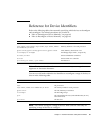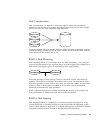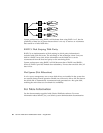
66 Sun Fire V490 Server Administration Guide • August 2004
■ Performance analysis tools, which enable you to monitor I/O performance and
isolate bottlenecks
■ A graphical user interface (GUI), which simplifies storage management
■ Support for online resizing, which enables volumes and their file systems to grow
and shrink online
■ Online reconfiguration facilities, which let you change to a different RAID
configuration or modify characteristics of an existing configuration
Multiplexed I/O (MPxIO)
A newer alternative to dynamic multipathing (DMP) that is also supported by the
Sun Fire V490 server is multiplexed I/O (MPxIO). Beginning with Solaris 8, MPxIO
is fully integrated within the Solaris OS software’s core I/O framework. MPxIO
enables you more effectively to represent and manage devices that are accessible
through multiple I/O controller interfaces within a single instance of the Solaris OS.
The MPxIO architecture:
■ Helps protect against I/O outages due to I/O controller failures. Should one I/O
controller fail, MPxIO automatically switches to an alternate controller.
■ Increases I/O performance by load balancing across multiple I/O channels.
Both Sun StorEdge T3 and Sun StorEdge A5x00 storage arrays are supported by
MPxIO on a Sun Fire V490 server. Supported I/O controllers are usoc/fp FC-AL
disk controllers and qlc/fp FC-AL disk controllers.
RAID Concepts
Solstice DiskSuite software supports RAID technology to optimize performance,
availability, and user cost. RAID technology improves performance, reduces
recovery time in the event of file system errors, and increases data availability even
in the event of a disk failure. There are several levels of RAID configurations that
provide varying degrees of data availability with corresponding trade-offs in
performance and cost.
This section describes some of the most popular and useful of those configurations,
including:
■ Disk concatenation
■ Disk mirroring (RAID 1)
■ Disk striping (RAID 0)
■ Disk striping with parity (RAID 5)
■ Hot spares


















